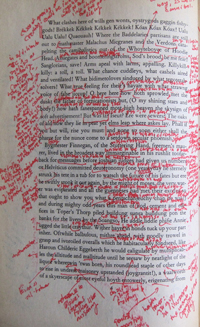
Source: Annotations Finnegans Wake, Karl Steel, Flickr
You are now going to quickly collect data about the two texts you read. This data will help you find connections between them.

The questions you will ask are basic and could be used with almost any fictional text. Use your notes to write your answers. When you’re finished, check your understanding to see a possible response.
- Who is the speaker in each text? What other characters appear besides the speaker? Is there a way to relate one text to the other by thinking about the speaker and other characters?
- What is the setting of each text?
- What is the most dramatic action in each selection?
- What is the reaction of each narrator to experiencing “wildness” in an animal?
- What words are used in the descriptions of the animals?
In the poem, the narrator is an adult reflecting on the times when she encountered snakes; we can say “she” because the voice seems to be identified with the poet. Along with the snake, other creatures make a brief appearance in the poem when the poet mentions “nature’s people.”
In the essay, the narrator is identified with the author; we will, therefore, refer to the narrator as “he.” The other “characters” in the excerpt are the cow that swims the river, the cattle that frisk about “like kittens, and the “supple cat tribe.” The texts can be connected through the narrators who are both human and interested in observing animals. The texts are similar when both narrators observe that animals have an untamed quality, a “wildness.”
In the poem, the setting is outdoors in an area where there is wildlife. The setting may be a farm (the reference to corn supports this). The time seems to be contemporary with the life of the poet (early nineteenth century); the reference to a “whip-lash” supports this timeframe, since a whip-lash was used to drive horses pulling a cart or a buggy.
The setting in the essay is also rural. The references to “my neighbor’s cow” and “a herd of a dozen bullocks and cows” support this statement. The time is after the introduction of “locomotives,” later than the early 1800s.
In the poem, the most dramatic action is probably when the narrator stoops to pick up the “whip-lash,” and it turns out to be a snake.
In the essay, the cow swimming in the river is a vivid image, but the more dramatic action is probably the description of the cows and bulls “running about and frisking” on the hill “like huge rats, even like kittens.”
In the poem, the narrator experiences an instinctive fear: “tighter breathing, and zero at the bone.” On the other hand, the narrator says “I feel for them a transport / Of cordiality” about “nature’s people” in general. She also refers to the snake as a “fellow,” which seems important. This is not a term you would use for a creature that completely terrifies you.
In the excerpt, the narrator rejoices in the wildness. He says he “loves to see” the animals acting as they would in the wild and “rejoices” that they have to be “broken.” In other words, he is glad that they are not naturally “slaves of men.”
In the poem, the poet describes the snake as “narrow,” a “fellow,” a “spotted shaft,” and implies that it is like a “whip-lash.”
In the excerpt, the narrator describes the cow as “bold,” and the herd as “dignified.” He describes the cattle as “sportive,” “like huge rats,” “like kittens,” and like a herd of deer. He also describes them, after domestication, as “beef,” “like the locomotive,” “palsied,” and “slaves of men.”
You could continue collecting more data, of course. You could, for instance, think of the tone in each text. You could pick out important sentences and phrases, or important objects, or even references to colors. The depth of your data collection depends on your purpose and on the time you have available.